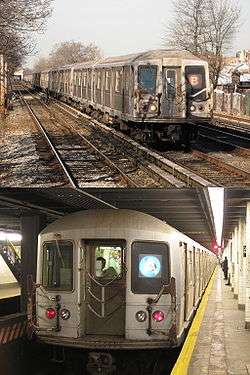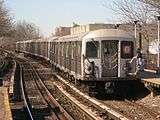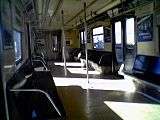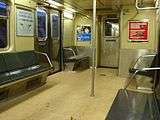R40 (New York City Subway car)
The R40 was a New York City Subway car model built by the St. Louis Car Company from 1967 to 1969 for the IND/BMT B Division. There were 400 cars in the R40 fleet, arranged in married pairs. Two versions of the R40 were manufactured: the original 200-car R40 order built in 1967-1968, and the supplementary 200-car R40A order built in 1968-1969. The 200 original R40s and the first 100 R40As were unique for their futuristic 10-degree slanted end (designed by the firm Raymond Loewy and Associates), and were nicknamed the R40 Slants or simply Slants.
| R40 | |
|---|---|
 Slant-ended (above) and modified straight-ended (below) variants | |
Interior of an R40 car | |
| In service | 1968–2009 |
| Manufacturer | St. Louis Car Company |
| Built at | St. Louis, Missouri, USA |
| Replaced | Many remaining BMT Standards |
| Constructed |
|
| Entered service | March 23, 1968 |
| Refurbished | 1987–1989 |
| Scrapped | 2008–2010, 2013 |
| Number built | 400
|
| Number preserved | 6 (2 R40s, 4 R40As) |
| Number scrapped | 394 |
| Fleet numbers |
|
| Capacity | 44 (seated) |
| Operator(s) | New York City Subway |
| Specifications | |
| Car body construction | Stainless steel sides with carbon steel chassis and underframes, fiberglass A-end bonnet |
| Car length | 60 ft 2.5 in (18.35 m) |
| Width | 9 ft 9 in (2.97 m) |
| Height | 12 ft 1.625 in (3.70 m) |
| Platform height | 3 ft 9.125 in (1.15 m) |
| Doors | 8 sets of 50 inch wide side doors per car |
| Maximum speed | 55 mph (89 km/h) |
| Weight | 77,695 lb (35,242 kg) (slant) 78,030 lb (35,394 kg) |
| Traction system | General Electric (GE) SCM 17KG192AE2 propulsion system using GE 1257E1 motors (115 hp or 85.76 kW per axle) |
| Acceleration | 2.5mph/s |
| Deceleration | ~3mph |
| Braking system(s) | WABCO "SMEE" Braking System, A.S.F. simplex unit cylinder clasp (tread) brake |
| Safety system(s) | emergency brakes |
| Headlight type | halogen light bulbs |
| Track gauge | 4 ft 8 1⁄2 in (1,435 mm) |
The first R40s entered service on March 23, 1968. Various modifications were made over the years to the R40 fleet, including a complete redesign to the last R40As. In 1988–1989, the R40s and R40As were rebuilt by Sumitomo. The R160 subway car order replaced all of the R40s and R40As from 2007 to 2009; the last slant-ended train ran on June 12, 2009, while the last straight-ended R40As ran on August 28, 2009. After being retired, most R40s and R40As were sunk into the ocean as artificial reefs, but a pair of R40 slants and several straight-ended R40As have survived.
Description
There were two versions of the R40: the original order from 1967-1968, and the second order, the R40As, built from 1968-1969. The R40s were originally numbered 4150–4249 and 4350–4449. In 1970, cars 4350–4449 were renumbered to 4250–4349. The slant-ended R40As were originally numbered 4450–4549, and the straight-ended R40As were originally numbered 4250–4349; these cars were later renumbered to 4350–4449 and 4450–4549, respectively.[1]
| Type | Original numbers | New numbers |
|---|---|---|
| R40 | 4150-4249 | Same |
| R40A (straight ends) | 4250-4349 | 4450-4549 |
| R40 | 4350-4449 | 4250-4349 |
| R40A (slant ends) | 4450-4549 | 4350-4449 |
The R40s and first 100 of the R40As were unique for their futuristic 10-degree slanted end (designed by the firm Raymond Loewy and Associates), and William Snaith Inc. were nicknamed the R40 Slants or simply Slants. This with intended to beautify the subway, and thus, making it more attractive to car users. However, the New York City Transit Authority found great dangers, along with other hazards and flaws, with the slanted end design; with the lack of handholds for riders walking between cars raising concerns of passengers falling onto the tracks. The doors between cars were closed to prevent accidents as a temporary solution. Within months, the cars were retrofitted at a cost of $215,000 with large grab rails with pantograph gates mounted, even though the director of the design from Raymond Loewy said that there was to be no passage between subway cars–the doors would be locked–and therefore the safety features were not needed. The modifications effectively destroyed Loewy's design, but allowed passengers to travel safely between cars.[2] In addition to modifying the R40s and slant-ended R40As, the last 100 R40As were built with a "modified" straight-ended version designed by Sundberg-Ferar (nicknamed the R40M), a form that is used on all other subway cars.[3]
The R40s and R40As introduced a new horizontal rollsign arrangement, replacing the pervious vertical arrangement that was last used on the R38 order from 1966. Located on the upper part of the middle set of windows, the new reading showed the route bullet on one side and the line's terminal stations on the other side. In addition, the driving ends of the train now feature a single rollsign, located on the opposite side of the driver's cabin, that displayed the route bullet, replacing the overhead twin rollsigns that displayed both the route bullet and directional terminal station. This pattern became standard for all subsequent orders, albeit with slight placement and design variations, until the R142 and R142A orders in 2000, which introduced LCD and LED signs that became standard for all New Technology Trains.
The R40As were delivered new with the same successful Stone Safety 10 ton air conditioning systems/units found on the last ten R38 cars, and became standard equipment on all future subway cars purchased from this point onward. As a result of the air conditioning, the standee poles were arranged in an alternating pattern rather than the straight-line pattern seen in the R40s, which lacked air conditioning systems/units until their overhauls.
History
In December 1965, the TA contracted Raymond Loewy and Associates to design a new subway car "dramatically different in exterior and interior." This design was planned to be used for 400 cars. The more attractive design was intended to get people out of their cars to use mass transit.[4] On September 20, 1966, the TA announced plans to order 400 new subway cars with this design. The cars were to have wider doors and windows, easier-to-read signage, and interiors with light colors. Bids were opened to the public on October 1, 1966. The cost was to be split evenly between the Federal Government and the city.[5] In November 1966, St. Louis Car Company was awarded the contract to construct 400 subway cars with the new design. The new cars cost $46,172,041.[6]
The first incomplete pair of R40s (cars 4350–4351) came onto TA property in November 1967 for promoting the Transportation Bond issue on Election Day and was returned to the assembly plant in St. Louis for completion and delivered in January 1968. On March 23, 1968, the R40 fleet entered service on the F.[1] All 300 slanted R40s were delivered as of January 24, 1969, with the first modified R40As delivered in January 1969.[7]
In 1977, pantograph gates, salvaged from retired R1 through R9 cars, were modified and then installed on the front ends of the straight-ended R40A and R42 cars. Baloney coiled spring type inter car safety barriers were installed on the blind ends of the married pairs. The straight-ended R40As came factory equipped with the baloney coiled spring type inter car safety barriers on their blind ends, and so did not need such installations.
Pairs 4200–4201 were badly damaged by a rear end accident on the North Channel Bridge on September 12, 1970, and 4420–4421 were damaged on February 12, 1974 when they were rear-ended by R6 # 1236 which also suffered extensive damage as well after it's handbrakes failed at Church Avenue & McDonald Av Station on the southbound express track between 7th Ave. and Church Ave, and were all scrapped in the 1983 prior to the overhaul of the R40s and R40As due to damage sustained in various accidents during the 1970s.
Overhaul and mishaps
In 1988–1989, the R40s and R40As were rebuilt by Sumitomo in Elmira Heights, New York. The interior was changed drastically and the MTA paint band was removed on all rebuilt cars. The R40s were retrofitted with air conditioning, and all cars received a new interior design.[1] Distinctive "EXP" (express) and "LOCAL" marker lights on the slant-ended cars were also removed.
Cars 4259, 4260, 4427, and 4428 were all involved in accidents after their overhaul. All cars except for 4259 were scrapped; however, 4259 never returned to service and was ultimately sunken as an artificial reef along with most other R40s and R40As. Cars 4258, 4261, 4426, and 4429, which lost their mates, were mated as pairs.
On June 5, 1995, R42 number 4664 was rear ended by straight-ended R40A number 4461 on the Williamsburg Bridge. The R42 was written off as it had sustained major damage, while the R40A was repaired and rebuilt into a slant-ended car. It was temporarily numbered 4260 as it was intended to be mated to R40 number 4259.[8][9] Meanwhile, straight-ended R40A number 4460 and R42 number 4665 became paired to each other. This pair today survives as part of the museum fleet.
Retirement
The R160 subway car order replaced all of the R40s and R40As from 2007 to 2009. The R40s and slant-ended R40As were retired and reefed from fall 2007 to June 12, 2009, when the last slant-ended train, consisting of R40A pairs 4414–4415, 4424–4425, 4432–4433, 4398–4399, and R40 pair 4256–4257, made its final trip on the A. The straight-ended R40As were retired starting in January 2009 until August 28, 2009, when the last pair, 4484–4485, ran on the V along with four R42 pairs.[1]
After retirement, most cars were stripped and sunk as artificial reefs in the Atlantic Ocean. The last R40/R40A cars to be removed from property by barge were R40 4272 and straight-ended R40As 4474–4475, which were reefed on April 17, 2010.[10] However, R40 pair 4162–4163 and slant-ended R40A pairs 4392–4393 and 4442–4443 were retained as school cars until 2013. These cars were eventually decommissioned and trucked to Sims Metal Management in Newark, New Jersey from April 2013 to October 1, 2013 for scrapping, as the reefing program had ended in April 2010.[1]
R40s 4280–4281 (originally 4380–4381) were preserved by the New York Transit Museum.[1][11] They were restored to operating status in 2013-2014 and have been operating on New York City Transit Museum-sponsored excursions since August 2014, specifically on the Train of Many Metals (TOMM). Before cars 4280–4281 were preserved, cars 4192–4193 were temporarily displayed at the New York Transit Museum in 2008, but they were later stripped and reefed.[12][13]
In addition to the R40 pair, several straight-ended R40As have survived. The full list includes:
- 4460 (and its R42 mate 4665) - preserved by the Railway Preservation Corporation and stored at Coney Island Yard.
- 4461 (rebuilt into a slant-ended car and renumbered to 4260) - currently at the Randall's Island FDNY Facility, used with R62s 1366 and 1370 as training cars.[14][15]
- Pair 4480–4481 - preserved by the New York Transit Museum. The cars were stored at the Concourse Yard until 2014, when they were moved to the 207th Street Yard.[16]
Gallery
.jpg) R40s 4280–4281 (originally 4380–4381) on display at the New York Transit Museum
R40s 4280–4281 (originally 4380–4381) on display at the New York Transit Museum An R40 train on the A at Jay Street-Borough Hall
An R40 train on the A at Jay Street-Borough Hall
 Interior of a slant-ended R40A car
Interior of a slant-ended R40A car Interior of a straight-ended R40A car
Interior of a straight-ended R40A car
References
- "www.nycsubway.org". www.nycsubway.org.
- Clines, Francis X. (August 12, 1970). "NEW SUBWAY CARS CALLED PERILOUS". The New York Times. ISSN 0362-4331. Retrieved December 25, 2016 – via New York Times Archives.
- Witkin, Richard (November 19, 1968). "A HAZARD IS FOUND ON NEW IND CARS; Authority Says Sloped Ends Leave Gap Between Units A Hazard Found in IND Subway Cars". The New York Times. Retrieved April 27, 2017.
- "New Design Is Sought For City Subway Car". The New York Times. December 6, 1965. ISSN 0362-4331. Retrieved April 27, 2017.
- "ATTRACTIVE CARS PLANNED FOR IND; Prettier Interior Is Stressed Doors Will Be Wider". The New York Times. September 21, 1966. ISSN 0362-4331.
- "Contract Awarded to Build 400 New Subway Cars". The New York Times. November 16, 1966. ISSN 0362-4331. Retrieved April 27, 2017.
- ERA Bulletin, March 2006, page 12. https://erausa.org/pdf/bulletin/2006-03-bulletin.pdf
- http://www.nycsubway.org/perl/show?5330
- http://www.nycsubway.org/perl/show?31752
- Chalasani, Radhika (September 17, 2015). "Watery grave for NYC subway cars". CBS News. Retrieved October 16, 2015.
- "Showing Image 107062". nycsubway.org.
- "Showing Image 79128". nycsubway.org.
- "Coney Island USA Bulletin Boards – Coney Island express train". coneyisland.com.
- http://www.rrpicturearchives.net/showPicture.aspx?id=674173
- http://subhysteria.wordpress.com/tag/scout/
Further reading
- Sansone, Gene. Evolution of New York City subways: An illustrated history of New York City's transit cars, 1867–1997. New York Transit Museum Press, New York, 1997 ISBN 978-0-9637492-8-4
External links
![]()